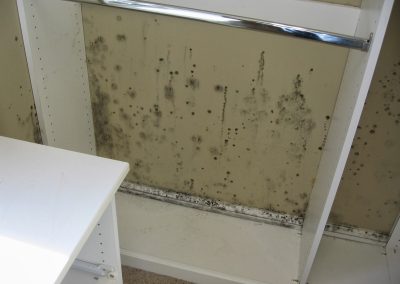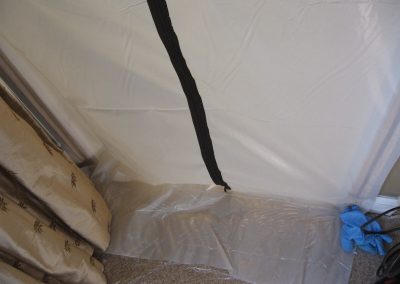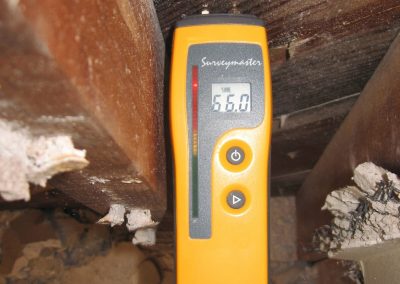Home »
A first-ring suburb of Columbus, Bexley is known for its historic and close-knit neighborhoods, its highly ranked public school system, its classic and walkable Main Street environment, the prestigious private schools located within its borders, and its status as the home of Capital University.
The historic homes in Bexley are very popular these days and seem to be under constant remodel and renovation. Case in point, the DIY project some homeowners completed overhauling their standard closet and creating a large walk-in closet. The project had been complete for several months and everything appeared normal. What the homeowner could not see was all of the moisture that was building up in the wood behind the new drywall they had installed. The Ohio winter weather has been very wet this year with all of the rain, snow and ice. All of this moisture finds its’ way into your home through holes in the roof, cracks in the walls, drafty windows, the basement and crawlspace. In this old house, the moisture had saturated the wood structure and began absorbing into the new drywall. The excess moisture in the drywall, coupled with the warm interior air in the home, led to mold growth. Once the homeowner saw the mold, they called The Basement Doctor call center and scheduled a free estimate with one of our Project Managers.
Upon arrival Ed Meyer, Senior Project Manager, found that the homeowners DIY project had unknowingly created the ultimate breeding ground for mold. When they enlarged the closet, they included a furnace register in the area. Since the door was typically closed on this closet and warm air was being pumped into the area with no circulation, the closet was quickly over ridden with mold due to high humidity levels. But no worries, The Basement Doctor is on the job!
Once our Foreman and his crew arrived at the house, they installed a zipper door to prevent the mold spores from contaminating the rest of the home during the remediation process. As they began deconstructing the closet shelving, it was clear that the mold was spreading everywhere. Once the mold covered drywall was ripped out, it exposed high wood moisture content feeding the outbreak. The maximum wood moisture should be between 15% to 16%. The wood supports measured nearly 30% and the outside wall measured 66%. These dangerously high moisture levels were then reduced to a safe 15% or less by drying the building materials with a combination of blowers and dehumidifiers. Next we treated the affected areas with Anabec Disinfectant killing any remaining mold, hepa vaced the closet space and finished off the remediation process by sealing and protecting the surfaces with Anabec X-70 Plus microbial coating to ensure the mold cannot return. Now that the area was dry and clean, we properly insulated between the posts using Basement Doctor Spray Foam. We also added high and low vents to ensure air circulation allowing for a consistent temperature to that found throughout the home. The area was then refinished with new drywall and a fresh coat of paint leaving the customer with a drier, cleaner, safer and healthier closet.
Quick Tips On Mold Courtesy of The Centers for Disease Control and Prevention https://www.cdc.gov/mold/faqs.htm:
What are molds?
Molds are fungi that can be found both indoors and outdoors. No one knows how many species of fungi exist but estimates range from tens of thousands to perhaps three hundred thousand or more. Molds grow best in warm, damp, and humid conditions, and spread and reproduce by making spores. Mold spores can survive harsh environmental conditions, such as dry conditions, that do not support normal mold growth.
How do molds affect people?
Some people are sensitive to molds. For these people, exposure to molds can cause symptoms such as nasal stuffiness, eye irritation, wheezing, or skin irritation. Some people, such as those with serious allergies to molds, may have more severe reactions. Severe reactions may occur among workers exposed to large amounts of molds in occupational settings, such as farmers working around moldy hay. Severe reactions may include fever and shortness of breath. Some people with chronic lung illnesses, such as obstructive lung disease, may develop mold infections in their lungs.
Specific Recommendations:
- Keep humidity levels as low as you can—no higher than 50%–all day long. An air conditioner or dehumidifier will help you keep the level low. Bear in mind that humidity levels change over the course of a day with changes in the moisture in the air and the air temperature, so you will need to check the humidity levels more than once a day.
- Use an air conditioner or a dehumidifier during humid months.
- Be sure the home has adequate ventilation, including exhaust fans.
- Add mold inhibitors to paints before application.
- Clean bathrooms with mold killing products.
- Do not carpet bathrooms and basements.
- Remove or replace previously soaked carpets and upholstery.




